Indirect Data Reduction¶
Overview¶
The Indirect Data Reduction interface provides the initial reduction that is used to convert raw instrument data to S(Q, w) for analysis in the Inelastic QENS Fitting and Bayes Fitting interfaces.
The tabs shown on this interface will vary depending on the current default facility such that only tabs that will work with data from the facility are shown, this page describes all the tabs which can possibly be shown.

Instrument Options¶
- Instrument
Used to select the instrument on which the data being reduced was created on.
- Analyser
The analyser bank that was active when the experiment was run, or for which you are interested in seeing the results of.
- Reflection
The reflection plane of the instrument set up.
Tip
If you need clarification as to the instrument setup you should use please speak to the instrument scientist who dealt with your experiment.
ISIS/ILL Energy Transfer¶
If the default facility has been set to ISIS, then the ISIS Energy Transfer tab will be available. However, this tab will be replaced by the ILL Energy Transfer tab if the default facility has been set to ILL. A further explanation of each tab can be found below.
ISIS Energy Transfer¶
This tab provides you with the functionality to convert the raw data from the experiment run into units of \(\Delta E\). See the algorithm ISISIndirectEnergyTransfer.
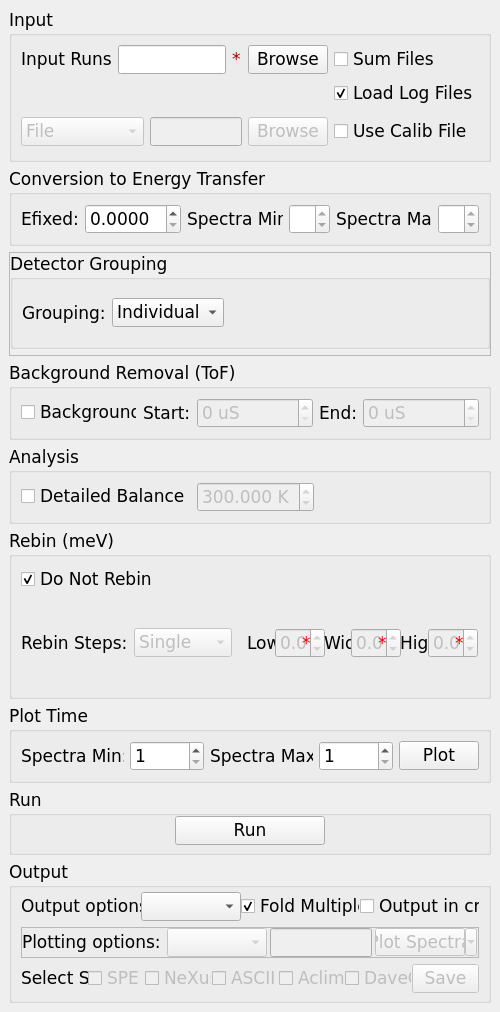
ISIS Energy Transfer Options¶
- Input Runs
Allows you to select the raw data files for an experiment. You can enter these either by clicking on the Browse button and selecting them, or entering the run numbers. Multiple files can be selected, multiple run numbers can be separated by a comma (,) or a range can be specified by using a dash (-).
- Sum Files
If selected the data from each raw file will be summed and from then on treated as a single run.
- Load Log Files
If selected the sample logs will be loaded from each of the run files.
- Use Calib File & Calibration File
Allows you to select a calibration file created using the Calibration tab.
- Efixed
This option allows you to override the default fixed final energy for the analyser and reflection number setting. This can be useful in correcting an offset peak caused by the sample being slightly out of centre.
- Spectra Min/Spectra Max
Used to specify a range of spectra.
- Detector Grouping
Used to specify a method for grouping detectors. Possible grouping options include ‘Individual’, ‘All’, ‘IPF’, ‘File’, ‘Groups’ and ‘Custom’. The TOSCA instrument will default to grouping using ‘IPF’, and the other instruments will default to ‘Individual’ grouping.
- Background Removal
Allows removal of a background given a time-of-flight range.
- Detailed Balance
Gives the option to perform an exponential correction on the data once it has been converted to Energy based on the temperature. This is automatically loaded from the sample logs of the input file if available.
- Scale by Factor
Gives the option to scale the output by a given factor.
- Do Not Rebin
If selected it will disable the rebinning step.
- Rebin Steps
Select the type of rebinning you wish to perform.
- Plot Time
Creates a time of flight plot of the grouping of the spectra in the range defined in the Plot Time section. To include a single spectrum, set the Spectra Min and Spectra Max selectors to the same value. Note that this first rebins the sample input to ensure that each detector spectrum has the same binning in order to be grouped into a single spectrum.
- Spectra Min & Spectra Max
Select the range of detectors you are interested in, default values are chosen based on the instrument and analyser bank selected.
- Run
Runs the processing configured on the current tab.
- Plot Spectra
If enabled, it will plot the selected workspace indices in the selected output workspace.
- Open Slice Viewer
If enabled, it will open the slice viewer for the selected output workspace.
- Group Output
This will place the output reduced files from a reduction into a group workspace.
- Fold Multiple Frames
This option is only relevant for TOSCA. If checked, then multiple-framed data will be folded back into a single spectra, if unchecked the frames will be left as is with the frame number given at the end of the workspace name.
- Output in \(cm^{-1}\)
Converts the units of the energy axis from \(meV\) to wave number (\(cm^{-1}\)).
- Select Save Formats
Allows you to select multiple output save formats to save the reduced data as, in all cases the file will be saved in the default save directory.
ISIS Energy Transfer Example Workflow¶
The ISIS Energy Transfer tab operates on raw TOF data files. Before starting this workflow, go to Manage Directories and make sure that Search Data Archive is set to all.
Set the Instrument to be OSIRIS, the Analyser to be graphite and the Reflection to be 002.
In Input Runs, enter the run numbers 104371-104375 and press enter.
Change the Spectra Min and Spectra Max if you want to avoid some of the detectors. For the purposes of this demonstration, keep them at their default values.
The Detector Grouping option allows you to specify how you want to group your detectors. The different option available are explained in the Grouping section. For this demonstration, choose Individual.
Click Run and wait for the interface to finish processing. This should generate a workspace ending in _red.
Choose a default save directory and then tick the Nexus checkbox. Click Save to save the output workspace. The workspace ending in _red will be used in the Elwin Example Workflow.
Go to the ISIS Calibration Example Workflow.
Grouping¶
The following options are available for grouping output data:
- Custom
Follows the same grouping patterns used in the GroupDetectors algorithm. An example of the syntax is 1,2+3,4-6,7:10
This would produce spectra for: spectra 1, the sum of spectra 2 and 3, the sum of spectra 4-6 (4+5+6) and individual spectra from 7 to 10 (7,8,9,10)
- Individual
All detectors will remain on individual spectra.
- Groups
The detectors will automatically be divided into a given number of equal size groups. Any left over will be added as an additional group.
- All
All detectors will be grouped into a single spectra.
- File
Gives the option of supplying a grouping file to be used with the GroupDetectors algorithm.
- Default
This grouping option is only available for TOSCA. It uses the spectra grouping specified in the IPF.
Rebinning¶
Rebinning can be done using either a single step or multiple steps as described in the sections below.
- Single
In this mode only a single binning range is defined as a range and width.

- Multiple
In this mode multiple binning ranges can be defined using the rebin string syntax used by the Rebin algorithm.
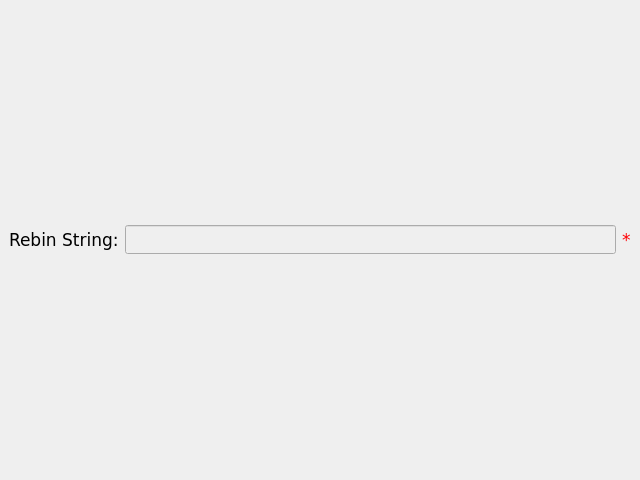
A note on Masked Detectors¶
When a reduction of a single run number takes place, the masked detectors used for the reduction are found using the IdentifyNoisyDetectors algorithm.
When using the Sum Files option the noisy detectors for each of the run numbers could be different. In this case, the masked detectors for the summed run is found by first finding the noisy detectors for each of the individual runs within the summed run using IdentifyNoisyDetectors. For instance, let us say that we find that the following run numbers have these noisy detectors:
Run number 22841 has noisy detectors 53, 54, 55
Run number 22842 has noisy detectors 53, 54, 56
Run number 22843 has noisy detectors 53, 55, 56
To find the detectors which should be masked for a summed run of 22841-22843 we first combine these noisy detectors so that we have 53, 54, 55 and 56. A summed file is then calculated from these run numbers and the IdentifyNoisyDetectors algorithm finds the noisy detectors for this summed file.
Summed file 22841-22843 has noisy detectors 13, 53, 54, 55
The masked detectors used for the summed run would also include any additional detectors found to be noisy for the summed run. The masked detectors used for the summed reduction of 22841-22843 would therefore be 13, 53, 54, 55 and 56.
ILL Energy Transfer¶
This tab handles the reduction of data from the IN16B instrument and will appear when the default facility is set to be the ILL. See the algorithm IndirectILLEnergyTransfer.
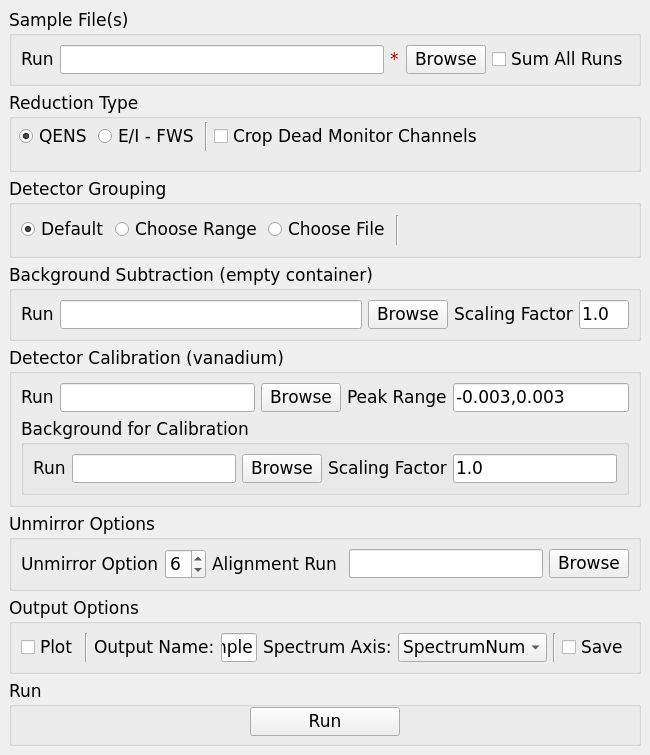
Reduction Type¶
There are two reduction types of IN16B data: Quasi-Elastic Neutron Scattering (QENS) or Fixed Window Scans (FWS). The latter can be either Elastic (EFWS) or Inelastic (IFWS). If one or another reduction type is checked, the corresponding algorithm will be invoked (see IndirectILLReductionQENS and IndirectILLReductionFWS). There are several properties in common between the two, and several others that are specific to one or the other. The specific ones will show up or disappear corresponding to the choice of the reduction type.
Common Options¶
- Input File
Used to select the raw data in
.nxsformat. Note that multiple files can be specified followingMultipleFilePropertyinstructions.- Detector Grouping
Used to switch between grouping as per the IDF (Default) or grouping using a mapping file (Map File). This defines e.g. the summing of the vertical pixels per PSDs.
- Background Subtraction
Used to specify the background (i.e. empty can) runs to subtract. A scale factor can be applied to background subtraction.
- Detector Calibration
Used to specify the calibration (i.e. vanadium) runs to divide by.
- Background Subtraction for Calibration
Used to specify the background (i.e. empty can) runs to subtract from the vanadium calibration runs.
- Output Name
This will be the name of the resulting reduced workspace group.
- Spectrum Axis
This allows the spectrum axis to be converted to elastic momentum transfer or scattering angle if desired.
- Plot
If enabled, it will plot the result (of the first run) as a contour plot.
- Save
If enabled the reduced workspace group will be saved as a
.nxsfile in the default save directory.
QENS-only Options¶
- Sum All Runs
If checked, all the input runs will be summed while loading.
- Crop Dead Monitor Channels
If checked, the few channels in the beginning and at the end of the spectra that contain zero monitor counts will be cropped out. As a result, the doppler maximum energy will be mapped to the first and last non-zero monitor channels, resulting in narrower peaks. Care must be taken with this option; since this alters the total number of bins, problems might occur while subtracting the background or performing unmirroring if the number of dead monitor channels are different.
- Calibration Peak Range
This defines the integration range over the peak in calibration run in
meV.- Unmirror Options
This is used to choose the option of summing of the left and right wings of the data, when recorded in mirror sense. See IndirectILLReductionQENS for full details. Unmirror option 5 and 7 require vanadium alignment run.
FWS-only Options¶
- Observable
This is the scanning observable, that will become the x-axis of the final result. It can be any numeric sample parameter defined in Sample Logs (e.g. sample.*) or a time-stamp string (e.g. start_time). It can also be the run number. It can not be an instrument parameter.
- Sort X Axis
If checked, the x-axis of the final results will be sorted.
- Sum/Interpolate
Both background and calibration have options to use the summed (averaged) or interpolated values over different observable points. Default behaviour is Sum. Interpolation is done using cubic (or linear for 2 measured values only) splines. If interpolation is requested, x-axis will be sorted automatically.
ISIS Calibration¶
This tab gives you the ability to create Calibration and Resolution files, and is only available when the default facility is set to ISIS.
The calibration file is normalised to an average of 1.
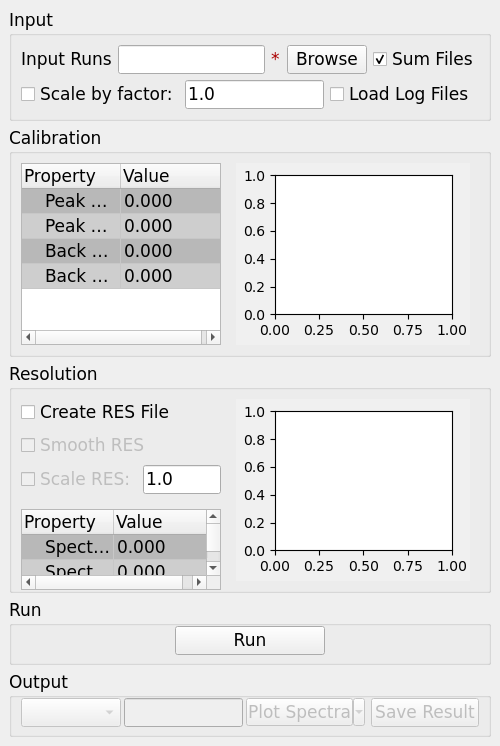
ISIS Calibration Options¶
- Input Runs
This allows you to select a run for the function to use, either by selecting the .raw file with the Browse button or through entering the number in the box.
- Plot Raw
Updates the preview plots.
- Intensity Scale Factor
Optionally applies a scale by a given factor to the raw input data.
- Load Log Files
This will load the log files if enabled.
- Run
Runs the processing configured on the current tab.
- Plot Spectra
If enabled, it will plot the selected workspace indices in the selected output workspace.
- Plot Bins
If enabled, it will plot the selected bin indices in the selected output workspace.
- Save Result
If enabled the result will be saved as a NeXus file in the default save directory.
Calibration¶
- Peak Min & Peak Max
Selects the time-of-flight range corresponding to the peak. A default starting value is generally provided from the instrument’s parameter file.
- Back Min & Back Max
Selects the time-of-flight range corresponding to the background. A default starting value is generally provided from the instrument’s parameter file.
Resolution¶
- Create RES File
If selected, it will create a resolution file when the tab is run.
- Smooth RES
If selected, the WienerSmooth algorithm will be applied to the output of the resolution algorithm.
- Scale RES
Applies a scale by a given factor to the resolution output.
- Spectra Min & Spectra Max
Allows restriction of the range of spectra used when creating the resolution curve.
- Background Start & Background End
Defines the time-of-flight range used to calculate the background noise.
- Low, Width & High
Binning parameters used to rebin the resolution curve.
Options¶
- Input Files
File for the calibration (e.g. vanadium) run. If multiple specified, they will be automatically summed.
- Grouping
Used to switch between grouping as per the IDF (Default) or grouping using a mapping file (Map File).
- Peak Range
Sets the integration range over the peak in \(meV\)
- Scale Factor
Factor to scale the intensities with
ISIS Calibration Example Workflow¶
The ISIS Calibration tab operates on raw TOF data files. Before starting this workflow, go to Manage Directories and make sure that Search Data Archive is set to all.
Set the Instrument to be IRIS, the Analyser to be graphite and the Reflection to be 002.
In Input Runs, enter the run number 26176 and press enter.
Tick Create RES File. This will create a workspace ending in _res.
Click Run and wait for the interface to finish processing. This should generate workspaces ending in _red, _res and _calib. The calibration workspace can be used in the ISIS Energy Transfer tab by ticking Use Calib File.
Select the workspace ending in _calib in the output options. Enter index 0 in the neighbouring box, and then click the down arrow on the Plot Spectra button, and select Plot Bins. This will plot the bin at index 0.
Select the workspace ending in _res in the output options. Enter index 0 in the neighbouring box, and then click the Plot Spectra button. This will plot the spectrum at workspace index 0.
Choose a default save directory and then click Save Result to save the workspaces ending in _res and _calib. The _res file is used in the I(Q, t) Example Workflow and Convolution Example Workflow. The _calib file is used in the ISIS Diagnostics Example Workflow.
ISIS Diagnostics¶
This tab allows you to perform an integration on a raw file over a specified time of flight range, and is equivalent to the Slice functionality found in MODES. It is only available when the default facility is set to ISIS.
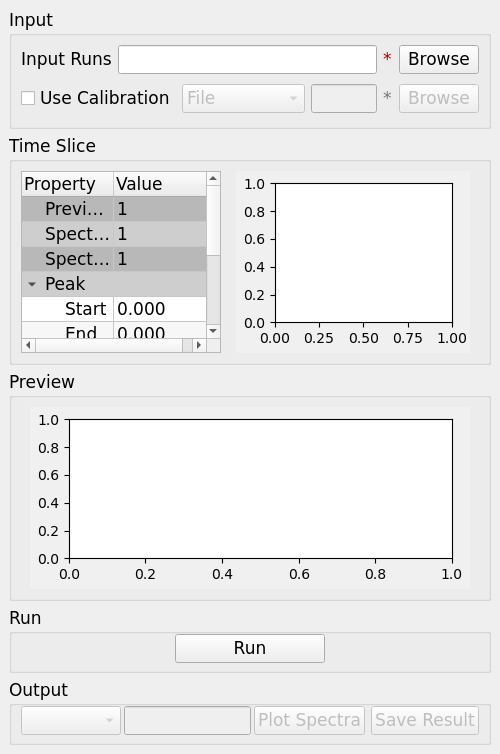
ISIS Diagnostics Options¶
- Input Runs
This allows you to select a run for the function to use, either by selecting the .raw file with the Browse button or through entering the number in the box. Multiple files can be selected, in the same manner as described for the Energy Transfer tab.
- Use Calibration
Allows you to select either a calibration file or workspace to apply to the raw files.
- Preview Spectrum
Allows selection of the spectrum to be shown in the preview plot to the right of the Time Slice section.
- Spectra Min & Spectra Max
Allows selection of the range of detectors you are interested in, this is automatically set based on the instrument and analyser bank that are currently selected.
- Peak
The time-of-flight range that will be integrated over to give the result (the blue range in the plot window). A default starting value is generally provided from the instrument’s parameter file.
- Use Two Ranges
If selected, enables subtraction of the background range.
- Background
An optional range denoting background noise that is to be removed from the raw data before the integration is performed. A default starting value is generally provided from the instrument’s parameter file.
- Run
Runs the processing configured on the current tab.
- Plot Spectra
If enabled, it will plot the selected workspace indices in the selected output workspace.
- Save Result
If enabled the result will be saved as a NeXus file in the default save directory.
ISIS Diagnostics Example Workflow¶
The ISIS Diagnostics tab operates on raw TOF data files. Before starting this workflow, go to Manage Directories and make sure that Search Data Archive is set to all.
Set the Instrument to be IRIS, the Analyser to be graphite and the Reflection to be 002.
In Input Runs, enter the run number 26176 and press enter.
Tick Use Calibration and load the file named
irs26173_graphite002_calib.Change the Preview Spectrum variable to view a different spectrum in the mini-plot.
Change the Start and End variables to specify a PeakRange for the TimeSlice algorithm. Alternatively, you can move the blue sliders on the mini-plot.
Click Run and wait for the interface to finish processing. This should generate a workspace ending in _slice. The Preview mini-plot will be updated.
Click Plot Spectra to produce a larger plot of the Preview mini-plot.
Go to the Transmission Example Workflow.
Transmission¶
Calculates the sample transmission using the raw data files of the sample and its background or container. The incident and transmission monitors are converted to wavelength and the transmission monitor is normalised to the incident monitor over the common wavelength range. The sample is then divided by the background/container to give the sample transmission as a function of wavelength.

Transmission Options¶
- Sample
Allows the selection of a raw file to be used as the sample.
- Background
Allows the selection of a raw file to be used as the background.
- Run
Runs the processing configured on the current tab.
- Plot Spectra
If enabled, it will plot the selected spectra indices in the selected output workspace.
- Save Result
If enabled the result will be saved as a NeXus file in the default save directory.
Transmission Example Workflow¶
The Transmission tab operates on raw TOF data files. Before starting this workflow, go to Manage Directories and make sure that Search Data Archive is set to all.
Set the Instrument to be IRIS, the Analyser to be graphite and the Reflection to be 002.
In the Sample box, enter the run number 26176 and press enter. In the Background box, enter the run number 26174 and press enter.
Click Run and wait for the interface to finish processing. This will run the algorithm IndirectTransmissionMonitor and plots the output workspaces in the Preview mini-plot.
Click Plot Spectra to produce a larger plot of the Preview mini-plot.
Go to the Symmetrise Example Workflow.
Categories: Interfaces | Indirect